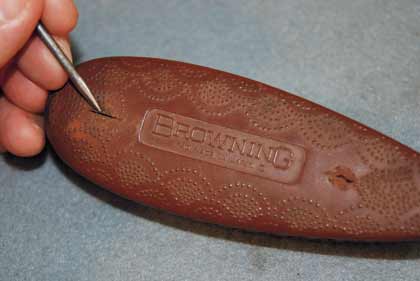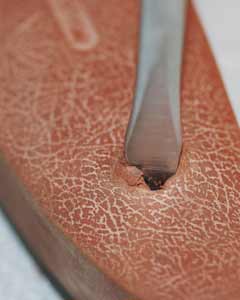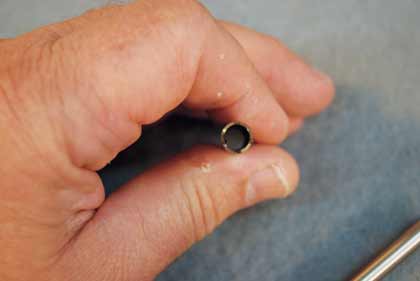September 23, 2010
By Reid Coffield
 Ragged, torn screw holes in the face of a recoil pad are distracting and often indicate poor gun care. But they can be fixed easily and without spending much money. |
Most rifles or shotguns, especially in the heavier-recoiling calibers, have a recoil pad of some sort. The pad may be original to the gun, or it might be one installed by the owner. These pads can be very beneficial and can make shooting a lot more enjoyable. Not many of us like recoil, and the older I get, the less I like it. For me, almost any recoil pad is helpful. Just about anything is better than a hard metal or plastic buttplate.
Unfortunately, many recoil pads have been inadvertently damaged or abused. More often than not, this is purely cosmetic, but it still detracts from the gun. In some cases it can lower the value of the gun.
Advertisement
If you're getting ready to sell a gun or buy a used one, you might want to consider what you can do to damaged or unsightly recoil pads. More often than not, folks think the only thing they can do is to have a gunsmith replace the pad, but that's not always necessary.
 A traditional flat-blade screwdriver can do an incredible amount of damage to the face of a recoil pad. Note how it is tearing the rubber around the screw slot. |
The most common type of damage is to the face, or rear surface, of the pad. Generally, the slots or holes that allow access to the two screws securing the pad to the stock are damaged. The rubber around the slot will be torn or ragged. This is normally due to the use of a flat-bladed screwdriver. The sharp edges of the flat screwdriver blade tear the rubber of the recoil pad as it's being turned to remove or install the screw. Even though it has little or no affect on the functioning of the gun and the pad, it looks just awful. As a friend once put it, "It looks like a rat was chewing on the pad."
Advertisement
If you are installing a new pad, you can generally avoid this problem by using a Phillips-head screw and a round-shank Phillips screwdriver. You can also lessen the stress on the pad by putting a dab of liquid soap or Vaseline on the face of the pad around the screw slot. In addition, I wipe down the shank of the Phillips screwdriver and the screw head with one of these lubricants. Almost anything you use or do to prevent the metal of the screwdriver and screw from grabbing the rubber of the recoil pad is helpful.
But what if you have a pad that's already damaged? What can you do to fix it and avoid the expense of replacing the pad? Fortunately, there's a simple solution that's quite easy and very inexpensive.
Several years ago I ran across a tool in a Woodcraft catalog that was ideal for this purpose. It's a screw extractor designed to remove sheared or broken wood screws. The tool is really a hollow, saw- toothed drill. If you have a broken wood screw with the head missing, you just center the screw extractor over the broken shank of the wood screw and drill down around it. You end up with a plug of wood containing the broken screw shank. It's fast and easy.
 A round-shank Phillips screwdriver will seldom tear or damage the face of a recoil pad to the same degree as a flat-blade screwdriver. |
 Screw extractor drills designed for woodworking are ideal for repairing damaged screw holes in recoil pads — they are hollow and can cut plugs of damaged rubber from the face of the pad. |
I bought a set of 'em and used them for this purpose for a number of years. They are available in 1/4- 5/16-, and 3/8-inch diameters. Then one day, I had a ruined recoil pad and was trying to figure out how to clean up the ragged screw slots. I'd tried a number of techniques over the years--including melting the rubber around the screw slot--with varying success.
As I thought about it, it occurred to me that my screw extractors might be just the ticket. Sure enough, they were.
You begin by removing the recoil pad from the gun. If your pad was held on by traditional slotted screws, this is an excellent time to replace them with Phillips-head screws. With the pad off the gun, use a white grease pencil to draw a line lengthwise down the center of the rear face of the pad. Hopefully, this line will pass over or at least be near the original screw slots. Since you will be making highly visible holes in the face of the pad, you want the holes to be as perfectly centered as possible. You don't want them too far to the left or right of this center line. If they are, it'll look uneven and be a distraction. If your existing screw slots are off center, you can offset the new holes to a degree. All that matters is that you clean up the damaged areas.
 Make sure the pad is held securely when drilling new screw holes. To help align the screw extractor drill, draw a line lengthwise down the center of the recoil pad face. |
Next, clamp or hold the pad under your drill press. Install the appropriate diameter screw extractor. I normally use the 1/4-inch diameter size. I think the smaller hole looks more attractive and professional. I generally set the speed of my drill press at about 3,000 rpm. This is not critical, but a higher speed does seem to cut cleaner.
Position the drill over the ragged hole and at the same time try to place the drill as close to the center line as possible. Slowly lower the screw extractor drill into the face of the pad. I usually go in about half the thickness of the pad. You definitely don't want to go too deep because you could hit the metal washers or liner that surrounds the screw holes on the base of the pad, and that would ruin both your screw extractor and the pad.
Once the new holes are cut, you may also want to use some 400-grit cloth-b
acked abrasive to lightly sand the sides of the pad. This will make the pad look newer.
With that done, the pad can be installed on the stock, and you're back in business.
This is an easy job that can quickly turn an eyesore into an asset. All it takes is a drill press and a screw extractor drill bit.
Until next time, good luck and good gunsmithing!
 The new screw holes are a lot cleaner and more professional looking than the original ragged, torn slots. |
